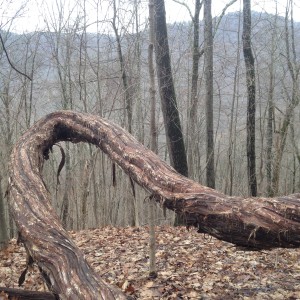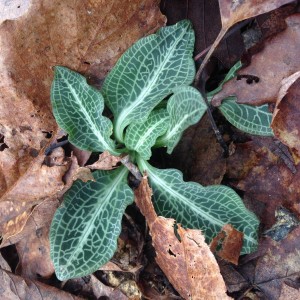Frozen Head
January can be dreary but I also know there is beauty in all things so yesterday I took off to find some! I drove 2 hours north to Frozen Head State Park, named for its highest, 3,324-foot peak. Though not frozen yesterday I am anxiously waiting for this to happen since I bought snowshoes! Recovering from ba ck surgery is not easy and it goes up and down during the healing process. I have found that though my ability to paddle and do shop work waxes and wanes in this process, I can always get out on a hike even if I have to choose a super easy one. And this I am very grateful for. So my optimistic thought process is, hey if I can hike, then I can snowshoe! Not sure how correct I am on that but I will test it when snow comes to the plateau and Smokies. Anyway, so off I went down the trail. And what I found was definitely worth the drive. It was not the first time I have been there. I visited the park back in 2012 during the spring when the wildflowers were blooming but a storm came in quickly and cut short my time there. This time it is winter and I had plenty of time to explore, my only limit being my back’s tolerance. I chose the North Old Mac and South Old Mac trails to make a 10 mile loop back to the parking lot. The climb up was awesome! Super peace
ck surgery is not easy and it goes up and down during the healing process. I have found that though my ability to paddle and do shop work waxes and wanes in this process, I can always get out on a hike even if I have to choose a super easy one. And this I am very grateful for. So my optimistic thought process is, hey if I can hike, then I can snowshoe! Not sure how correct I am on that but I will test it when snow comes to the plateau and Smokies. Anyway, so off I went down the trail. And what I found was definitely worth the drive. It was not the first time I have been there. I visited the park back in 2012 during the spring when the wildflowers were blooming but a storm came in quickly and cut short my time there. This time it is winter and I had plenty of time to explore, my only limit being my back’s tolerance. I chose the North Old Mac and South Old Mac trails to make a 10 mile loop back to the parking lot. The climb up was awesome! Super peace ful, serene, Cumberland beauty. I could see the big peaks surrounding me through the bare trees draped with giant grapevines. These vines are fascinating, reaching way up into the tallest trees. The question is how do they get up there? The vines do not grasp with root like extensions or twine themselves around living things for support. They are instead more like gentle giants. They lie in wait for the surrounding structure of the forest to lift them up. On and on they go r
ful, serene, Cumberland beauty. I could see the big peaks surrounding me through the bare trees draped with giant grapevines. These vines are fascinating, reaching way up into the tallest trees. The question is how do they get up there? The vines do not grasp with root like extensions or twine themselves around living things for support. They are instead more like gentle giants. They lie in wait for the surrounding structure of the forest to lift them up. On and on they go r iding on the surfaces of its neighbors as they reach higher and higher for sunlight. They create this elegant linear tapestry within the matrix of the forest. Next time you are out in the woods, check them out and see where they go. The next giant I came across was a beautiful species of shelf fungi. I have been looking at lots of fungi this winter on all my pre and post back surgery adventures. Living in a temperate moist climate brings out tons of different shapes and sizes of fungi. The structures they create are elegant beyond belief and always gives me tons to think about from a biological, functional point of view. Beauty is here in all things, even in death. The death of the forest turns into a natural canvas on which the fungi find a place to create. But Frozen Head also has much smaller forest members that can be seen on the trail in winter. There is a species of Orchid that lives on the Plateau called the Downy Rattlesnake Plaintain, or Goodyera pubescens, for all my botanist friends out there. I was lucky enough to come across several. Seeing these small spots of green in the forest in winter is always exciting and again, thought provoking. How does an orchid survive this way through the harsh Cumberland winter? It stays green capitalizing on the light coming through a now unshaded forest floor and stores the energy it captures in dense root tissue. It can take years however for the Orchid to bloom so if you happen to come across a blooming Downy Rattlesnake Plaintain in July, count yourself lucky. Happy trails!
iding on the surfaces of its neighbors as they reach higher and higher for sunlight. They create this elegant linear tapestry within the matrix of the forest. Next time you are out in the woods, check them out and see where they go. The next giant I came across was a beautiful species of shelf fungi. I have been looking at lots of fungi this winter on all my pre and post back surgery adventures. Living in a temperate moist climate brings out tons of different shapes and sizes of fungi. The structures they create are elegant beyond belief and always gives me tons to think about from a biological, functional point of view. Beauty is here in all things, even in death. The death of the forest turns into a natural canvas on which the fungi find a place to create. But Frozen Head also has much smaller forest members that can be seen on the trail in winter. There is a species of Orchid that lives on the Plateau called the Downy Rattlesnake Plaintain, or Goodyera pubescens, for all my botanist friends out there. I was lucky enough to come across several. Seeing these small spots of green in the forest in winter is always exciting and again, thought provoking. How does an orchid survive this way through the harsh Cumberland winter? It stays green capitalizing on the light coming through a now unshaded forest floor and stores the energy it captures in dense root tissue. It can take years however for the Orchid to bloom so if you happen to come across a blooming Downy Rattlesnake Plaintain in July, count yourself lucky. Happy trails!


